My G/F-Body
History
It all began back in 1994
while I was attending the Fort Wayne, Indiana Anthis Career Center Automotive
Program. I was 18 years old and it was my senior year of high
school. The instructor I had for Fuel and Ignition class got me interested
in fuel injection about one week into the coarse. Ever since then, my
abilities with converting and modifying vehicles for use with electronic fuel
injection have exploded into a great achievement. Below are some details
and pictures of my progress from the beginning...
1985 Buick Regal
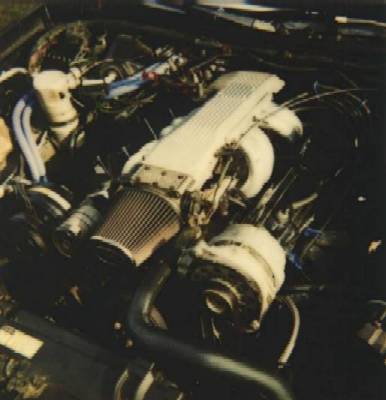 Originally
equipped with a 2bbl carbureted 231 ci V6, I was successful in converting it to
Throttle Body Injection (TBI) using a 4.3L truck computer and wiring
system. It was a wiring mess, but worked better than the carb it
replaced. Soon I was introduced to a very nice gentleman that managed a
local salvage yard who found me a used chevy 350 that was in a totaled S-10
pickup truck. I bought this engine and installed it into my car with
minimal effort and tried out the 4bbl quadrajet that came on it. Soon I
discovered that the carb had problems and it was soon replaced by the same TBI
system I used for the V6. Soon after this, I replaced the tired TH-350
transmission that came with the small block in favor of a '94 model 4L60-E
transmission that I acquired. I switched the control system over to a 94
C/K pickup system to handle both the transmission and engine. In time I
got bored of the 2bbl TBI setup and opted for a Tuned Port Injection system that
I found off a 305 for $300. Using wiring diagrams for both a 94 C/K and 91
Z/28 I was able to run two computers in the same car without problem. The
TPI worked beautifully in comparison to the TBI or the 4bbl carb. More
torque and HP than I could have imagined for so little of cost.
Originally
equipped with a 2bbl carbureted 231 ci V6, I was successful in converting it to
Throttle Body Injection (TBI) using a 4.3L truck computer and wiring
system. It was a wiring mess, but worked better than the carb it
replaced. Soon I was introduced to a very nice gentleman that managed a
local salvage yard who found me a used chevy 350 that was in a totaled S-10
pickup truck. I bought this engine and installed it into my car with
minimal effort and tried out the 4bbl quadrajet that came on it. Soon I
discovered that the carb had problems and it was soon replaced by the same TBI
system I used for the V6. Soon after this, I replaced the tired TH-350
transmission that came with the small block in favor of a '94 model 4L60-E
transmission that I acquired. I switched the control system over to a 94
C/K pickup system to handle both the transmission and engine. In time I
got bored of the 2bbl TBI setup and opted for a Tuned Port Injection system that
I found off a 305 for $300. Using wiring diagrams for both a 94 C/K and 91
Z/28 I was able to run two computers in the same car without problem. The
TPI worked beautifully in comparison to the TBI or the 4bbl carb. More
torque and HP than I could have imagined for so little of cost.
1986 Chevrolet
Monte Carlo
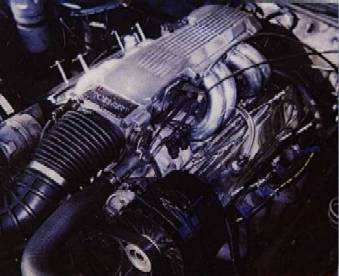 After
losing the Regal to an accident caused by an uninsured motorist, I used the
small amount of insurance money to purchase a base model Monte. This car
was in much better shape than the previous G-body, weighed in about 200 lbs less
and came factory equipped with a 4.3L TBI V6. Using the factory EFI fuel
lines and wiring harness, installation of the 350 TPI engine was a snap.
It also made it easier to clean up the wiring mess that I had before. Later down
the road, I decided it was time for an upgrade. I switched the engine
control system to an 89 Mass Air system that eliminated a lot of part throttle
hesitations associated with the modified engine using a speed density MAP
system. I rebuilt a late model L-98 4-bolt main, roller block in which I
installed a set of Trick Flow Specialties Twisted Wedge Aluminum heads and a LT4
HOTCAM roller camshaft. This combination was outrageous! The car ran
13.6s in the 1/4 mile with a mildly ported stock Tuned Port intake. Other
mods at the time were: Functioning A/C; 3.73 gear, limited slip 7.5 rear
axle; headers; terminator mufflers; S-10 Blazer mini-starter; 2295 rpm stall; Fairbanks
billet 2-4 servo; shift solenoid override switches; and a 96 S-10 instrument
cluster. This setup and the car weighed in at 3624 lbs without driver.
After
losing the Regal to an accident caused by an uninsured motorist, I used the
small amount of insurance money to purchase a base model Monte. This car
was in much better shape than the previous G-body, weighed in about 200 lbs less
and came factory equipped with a 4.3L TBI V6. Using the factory EFI fuel
lines and wiring harness, installation of the 350 TPI engine was a snap.
It also made it easier to clean up the wiring mess that I had before. Later down
the road, I decided it was time for an upgrade. I switched the engine
control system to an 89 Mass Air system that eliminated a lot of part throttle
hesitations associated with the modified engine using a speed density MAP
system. I rebuilt a late model L-98 4-bolt main, roller block in which I
installed a set of Trick Flow Specialties Twisted Wedge Aluminum heads and a LT4
HOTCAM roller camshaft. This combination was outrageous! The car ran
13.6s in the 1/4 mile with a mildly ported stock Tuned Port intake. Other
mods at the time were: Functioning A/C; 3.73 gear, limited slip 7.5 rear
axle; headers; terminator mufflers; S-10 Blazer mini-starter; 2295 rpm stall; Fairbanks
billet 2-4 servo; shift solenoid override switches; and a 96 S-10 instrument
cluster. This setup and the car weighed in at 3624 lbs without driver.
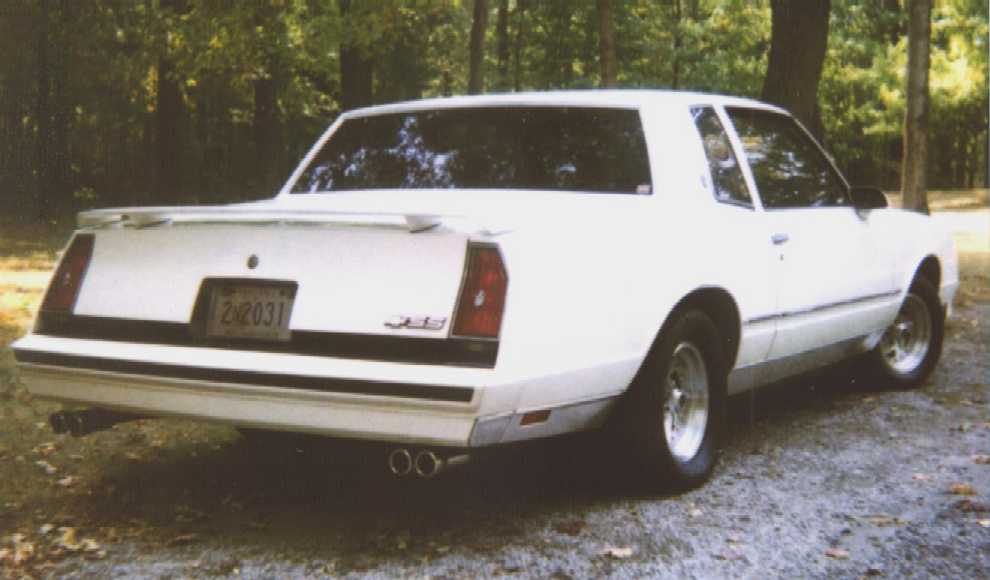
The MiniRam
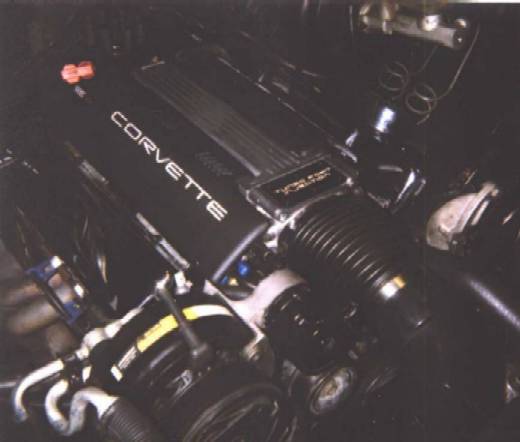 After
rebuilding from an unfortunate valve problem (TFS manufacture defect), I ordered
the Miniram II intake manifold. TPIS claimed the intake would produce
100+hp and 100+tq over the stock TPI intake. It was a fabulous and
impressive looking one-piece casting. I quickly swapped out the old TPI in
favor of this new bolt-on power adder to be surprised that it was not what it
was cracked up to be. The car lost all of its low end grunt. With
the TPI, the engine pulled strong from 3000 rpm to about 5300 rpm when it ran
out of steam. This intake made the engine pull like a 4 cylinder until
about 5000 rpm when it decided to take off like a rocket with no end in
sight. This would have been fine if the engine was backed by a manual
gearbox or the bottom end was enforced by 4340 billet steel, but those things
were out of my reach at the time, especially after dropping over $1100 into the
entire MiniRam package. Under advice from a TPIS tech rep, I swapped out
the HOTCAM with a smaller, more low-end oriented grind by Comp Cams. I was
informed that the combination I was running would benefit from a different
cam. I was disappointed from the results. The engine now pulled from
4500 until about 5700 when it fell flat on its face. A couple of months
later, the small cam came out and the HOTCAM went back in. Later, I tried
a 52mm throttle body and found that the car got .2 sec slower than with the 48mm
stocker. Another surprise. This was probably due to velocity and
optimum manifold filling. I never got a chance to make it to the track in
this car with this setup before the incident with the tree but my best estimates
were 13.5sec in the 1/4...
After
rebuilding from an unfortunate valve problem (TFS manufacture defect), I ordered
the Miniram II intake manifold. TPIS claimed the intake would produce
100+hp and 100+tq over the stock TPI intake. It was a fabulous and
impressive looking one-piece casting. I quickly swapped out the old TPI in
favor of this new bolt-on power adder to be surprised that it was not what it
was cracked up to be. The car lost all of its low end grunt. With
the TPI, the engine pulled strong from 3000 rpm to about 5300 rpm when it ran
out of steam. This intake made the engine pull like a 4 cylinder until
about 5000 rpm when it decided to take off like a rocket with no end in
sight. This would have been fine if the engine was backed by a manual
gearbox or the bottom end was enforced by 4340 billet steel, but those things
were out of my reach at the time, especially after dropping over $1100 into the
entire MiniRam package. Under advice from a TPIS tech rep, I swapped out
the HOTCAM with a smaller, more low-end oriented grind by Comp Cams. I was
informed that the combination I was running would benefit from a different
cam. I was disappointed from the results. The engine now pulled from
4500 until about 5700 when it fell flat on its face. A couple of months
later, the small cam came out and the HOTCAM went back in. Later, I tried
a 52mm throttle body and found that the car got .2 sec slower than with the 48mm
stocker. Another surprise. This was probably due to velocity and
optimum manifold filling. I never got a chance to make it to the track in
this car with this setup before the incident with the tree but my best estimates
were 13.5sec in the 1/4...
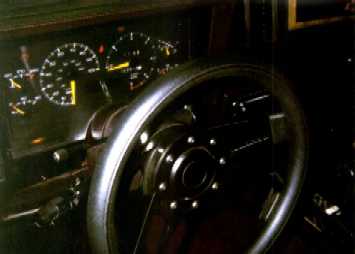
1986 Pontiac Trans
Am
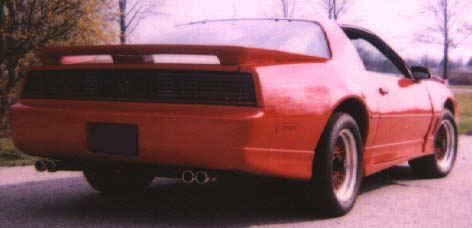 About
a month after making it home from the hospital a friend of mine found a red 86
T/A that was in excellent condition for the price of $1000. Of course, the
MiniRamed 355 was salvaged and eventually found its way into this car after many
months of agonizing recovery on my part. Not too many modifications were
performed to the previous setup with the exception of different exhaust and
induction work as well as 4.10 gears before this car got nailed by a red light
runner.
About
a month after making it home from the hospital a friend of mine found a red 86
T/A that was in excellent condition for the price of $1000. Of course, the
MiniRamed 355 was salvaged and eventually found its way into this car after many
months of agonizing recovery on my part. Not too many modifications were
performed to the previous setup with the exception of different exhaust and
induction work as well as 4.10 gears before this car got nailed by a red light
runner.
then came the 1987
Pontiac GTA
Which brings us to where I
am today. For a complete listing of modifications, see the chassis and
driveline sections of my GTA site. For any other questions concerning this
site or modifications I have performed, please feel free to
email me.
www.gmtuners.com
 Originally
equipped with a 2bbl carbureted 231 ci V6, I was successful in converting it to
Throttle Body Injection (TBI) using a 4.3L truck computer and wiring
system. It was a wiring mess, but worked better than the carb it
replaced. Soon I was introduced to a very nice gentleman that managed a
local salvage yard who found me a used chevy 350 that was in a totaled S-10
pickup truck. I bought this engine and installed it into my car with
minimal effort and tried out the 4bbl quadrajet that came on it. Soon I
discovered that the carb had problems and it was soon replaced by the same TBI
system I used for the V6. Soon after this, I replaced the tired TH-350
transmission that came with the small block in favor of a '94 model 4L60-E
transmission that I acquired. I switched the control system over to a 94
C/K pickup system to handle both the transmission and engine. In time I
got bored of the 2bbl TBI setup and opted for a Tuned Port Injection system that
I found off a 305 for $300. Using wiring diagrams for both a 94 C/K and 91
Z/28 I was able to run two computers in the same car without problem. The
TPI worked beautifully in comparison to the TBI or the 4bbl carb. More
torque and HP than I could have imagined for so little of cost.
Originally
equipped with a 2bbl carbureted 231 ci V6, I was successful in converting it to
Throttle Body Injection (TBI) using a 4.3L truck computer and wiring
system. It was a wiring mess, but worked better than the carb it
replaced. Soon I was introduced to a very nice gentleman that managed a
local salvage yard who found me a used chevy 350 that was in a totaled S-10
pickup truck. I bought this engine and installed it into my car with
minimal effort and tried out the 4bbl quadrajet that came on it. Soon I
discovered that the carb had problems and it was soon replaced by the same TBI
system I used for the V6. Soon after this, I replaced the tired TH-350
transmission that came with the small block in favor of a '94 model 4L60-E
transmission that I acquired. I switched the control system over to a 94
C/K pickup system to handle both the transmission and engine. In time I
got bored of the 2bbl TBI setup and opted for a Tuned Port Injection system that
I found off a 305 for $300. Using wiring diagrams for both a 94 C/K and 91
Z/28 I was able to run two computers in the same car without problem. The
TPI worked beautifully in comparison to the TBI or the 4bbl carb. More
torque and HP than I could have imagined for so little of cost. After
losing the Regal to an accident caused by an uninsured motorist, I used the
small amount of insurance money to purchase a base model Monte. This car
was in much better shape than the previous G-body, weighed in about 200 lbs less
and came factory equipped with a 4.3L TBI V6. Using the factory EFI fuel
lines and wiring harness, installation of the 350 TPI engine was a snap.
It also made it easier to clean up the wiring mess that I had before. Later down
the road, I decided it was time for an upgrade. I switched the engine
control system to an 89 Mass Air system that eliminated a lot of part throttle
hesitations associated with the modified engine using a speed density MAP
system. I rebuilt a late model L-98 4-bolt main, roller block in which I
installed a set of Trick Flow Specialties Twisted Wedge Aluminum heads and a LT4
HOTCAM roller camshaft. This combination was outrageous! The car ran
13.6s in the 1/4 mile with a mildly ported stock Tuned Port intake. Other
mods at the time were: Functioning A/C; 3.73 gear, limited slip 7.5 rear
axle; headers; terminator mufflers; S-10 Blazer mini-starter; 2295 rpm stall; Fairbanks
billet 2-4 servo; shift solenoid override switches; and a 96 S-10 instrument
cluster. This setup and the car weighed in at 3624 lbs without driver.
After
losing the Regal to an accident caused by an uninsured motorist, I used the
small amount of insurance money to purchase a base model Monte. This car
was in much better shape than the previous G-body, weighed in about 200 lbs less
and came factory equipped with a 4.3L TBI V6. Using the factory EFI fuel
lines and wiring harness, installation of the 350 TPI engine was a snap.
It also made it easier to clean up the wiring mess that I had before. Later down
the road, I decided it was time for an upgrade. I switched the engine
control system to an 89 Mass Air system that eliminated a lot of part throttle
hesitations associated with the modified engine using a speed density MAP
system. I rebuilt a late model L-98 4-bolt main, roller block in which I
installed a set of Trick Flow Specialties Twisted Wedge Aluminum heads and a LT4
HOTCAM roller camshaft. This combination was outrageous! The car ran
13.6s in the 1/4 mile with a mildly ported stock Tuned Port intake. Other
mods at the time were: Functioning A/C; 3.73 gear, limited slip 7.5 rear
axle; headers; terminator mufflers; S-10 Blazer mini-starter; 2295 rpm stall; Fairbanks
billet 2-4 servo; shift solenoid override switches; and a 96 S-10 instrument
cluster. This setup and the car weighed in at 3624 lbs without driver.
 After
rebuilding from an unfortunate valve problem (TFS manufacture defect), I ordered
the Miniram II intake manifold. TPIS claimed the intake would produce
100+hp and 100+tq over the stock TPI intake. It was a fabulous and
impressive looking one-piece casting. I quickly swapped out the old TPI in
favor of this new bolt-on power adder to be surprised that it was not what it
was cracked up to be. The car lost all of its low end grunt. With
the TPI, the engine pulled strong from 3000 rpm to about 5300 rpm when it ran
out of steam. This intake made the engine pull like a 4 cylinder until
about 5000 rpm when it decided to take off like a rocket with no end in
sight. This would have been fine if the engine was backed by a manual
gearbox or the bottom end was enforced by 4340 billet steel, but those things
were out of my reach at the time, especially after dropping over $1100 into the
entire MiniRam package. Under advice from a TPIS tech rep, I swapped out
the HOTCAM with a smaller, more low-end oriented grind by Comp Cams. I was
informed that the combination I was running would benefit from a different
cam. I was disappointed from the results. The engine now pulled from
4500 until about 5700 when it fell flat on its face. A couple of months
later, the small cam came out and the HOTCAM went back in. Later, I tried
a 52mm throttle body and found that the car got .2 sec slower than with the 48mm
stocker. Another surprise. This was probably due to velocity and
optimum manifold filling. I never got a chance to make it to the track in
this car with this setup before the incident with the tree but my best estimates
were 13.5sec in the 1/4...
After
rebuilding from an unfortunate valve problem (TFS manufacture defect), I ordered
the Miniram II intake manifold. TPIS claimed the intake would produce
100+hp and 100+tq over the stock TPI intake. It was a fabulous and
impressive looking one-piece casting. I quickly swapped out the old TPI in
favor of this new bolt-on power adder to be surprised that it was not what it
was cracked up to be. The car lost all of its low end grunt. With
the TPI, the engine pulled strong from 3000 rpm to about 5300 rpm when it ran
out of steam. This intake made the engine pull like a 4 cylinder until
about 5000 rpm when it decided to take off like a rocket with no end in
sight. This would have been fine if the engine was backed by a manual
gearbox or the bottom end was enforced by 4340 billet steel, but those things
were out of my reach at the time, especially after dropping over $1100 into the
entire MiniRam package. Under advice from a TPIS tech rep, I swapped out
the HOTCAM with a smaller, more low-end oriented grind by Comp Cams. I was
informed that the combination I was running would benefit from a different
cam. I was disappointed from the results. The engine now pulled from
4500 until about 5700 when it fell flat on its face. A couple of months
later, the small cam came out and the HOTCAM went back in. Later, I tried
a 52mm throttle body and found that the car got .2 sec slower than with the 48mm
stocker. Another surprise. This was probably due to velocity and
optimum manifold filling. I never got a chance to make it to the track in
this car with this setup before the incident with the tree but my best estimates
were 13.5sec in the 1/4...
 About
a month after making it home from the hospital a friend of mine found a red 86
T/A that was in excellent condition for the price of $1000. Of course, the
MiniRamed 355 was salvaged and eventually found its way into this car after many
months of agonizing recovery on my part. Not too many modifications were
performed to the previous setup with the exception of different exhaust and
induction work as well as 4.10 gears before this car got nailed by a red light
runner.
About
a month after making it home from the hospital a friend of mine found a red 86
T/A that was in excellent condition for the price of $1000. Of course, the
MiniRamed 355 was salvaged and eventually found its way into this car after many
months of agonizing recovery on my part. Not too many modifications were
performed to the previous setup with the exception of different exhaust and
induction work as well as 4.10 gears before this car got nailed by a red light
runner.